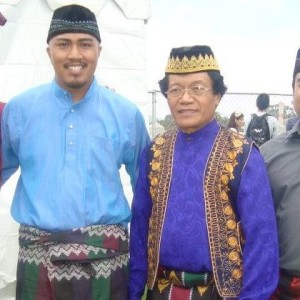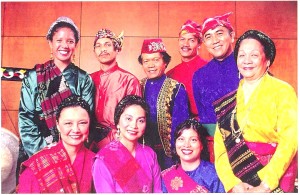Kulintang master Kalanduyan passes away in California
SAN FRANCISCO – The father of Filipino American kulintang music, Danongan Sibay Kalanduyan, passed away on September 28, 2016. In his wake lies a solid foundation and an enduring legacy of an authentic Philippine musical form woven into the fabric and sonic landscape of Filipino American culture and experience.
Also known as Guro (teacher), Master K, or simply Danny, Kalanduyan was born in Datu Piang, Maguindanao, Philippines on May 1, 1947 to a family of musicians who made a living as farmers. Kalanduyan’s mother was an excellent kulintang player and his earliest memory was sitting on his mother’s lap while she guided his hands on the kulintang. By learning through doing and experience, a method he would later apply to his students, he mastered the instrument that he had been playing since he was four.
Kalanduyan was a student at the Mindanao State University in Marawi where his extraordinary talent was recognized by the founder of the Darangan Cultural Troupe (DCT) Professor Henrietta Ele. He would slip into the university’s Aga Khan museum and play the kulintang.
“One day Mrs. Ele came in and she hears this kulintang music and immediately thought ‘who is this! You are joining the Darangan Cultural Troupe!’” says Titania Buchholdt, musician, his closest collaborator and confidant of 20 years, and co-founder of the Mindanao Lilang-lilang, a non-profit they started by Kalanduyan to bring the indigenous pre-colonial music and performing arts of the southern Philippines to America.
Kalanduyan at first thought it strange that people gave performances of indigenous music and dance since it was something that his family ordinarily did after working all day in the fields. With DCT, Kalanduyan toured the Philippines, playing the kulintang, honing his skills and performance. This would lead to a life-changing opportunity.
Pre-colonial form
Kulintang is a pre-colonial musical form and tradition that went through centuries of development into a highly advanced, complex and transcendental art form. The kulintang is a set of eight small-bossed gongs in graduated sizes horizontally laid on a rack and played with a pair of soft wooden sticks.

Danongan Kalanduyan with Titania Buchholdt performing at the University of Hawaii-Manoa in 1999. CONTRIBUTED
The most performed type of Maguindanaon music, kulintang also refers to the ensemble that includes four other instruments: the babendil, a small vertical hand-held gong; dabakan, a single-headed wooden drum; agung, a large wide-rimmed vertical-hanging gong; and gandingan, a set of four large, shallow vertical-hanging gongs used to mimic the intonations of human speech and therefore known as “talking gongs.”
Kulintang music officially came to America through the work of Dr. Robert Garfias, a prominent figure in ethnomusicology and currently anthropology professor at University of California at Irvine, who taught at the University of Washington. The counter-culture revolution of the ‘60s led to great interest in international cultures. Dr. Garfias had done extensive field research for the graduate program in ethnomusicology that he established at the University of Washington. Kulintang was on his list.
He wanted someone who was born and raised with the culture to enter the program and teach. In his search, Garfias went to the Mindanao State University at Marawi City where he heard and saw candidates for the position.
Kalanduyan came to America through a Rockefeller grant in 1976 as artist-in-residence at the University of Washington. He became proficient in teaching kulintang and earned his master’s degree in ethnomusicology.
Reclaiming heritage
In the 1980s young Filipino Americans were starving to reconnect and reclaim their very own heritage and tradition that had been erased by westernization. Robert Kikuchi-Yngojo, a Japanese Filipino American artist who had studied kulintang in the Philippines, founded the performing arts ensemble SF Kulintang in 1982–then composed of Kikuchi-Yngojo, Robert Henry, Marcella Pabros, and Alleluia Panis.
“We were floored and in awe that there was music indigenous to the Philippines that is as complex as kulintang,” recalls Alleluia Panis, dance artist and artistic and executive director of Kularts. “It was exactly what we needed as people who grew up in a society where we are second class citizens and were told that Filipinos don’t have original music. It was liberating and gave us a renewed sense of pride and respect for our culture and identity.”

Subla members (left to right) Frank Holder, Robert Rios and Danny Kalanduyan with the Los Angeles Master Choral performing at the Walt Disney Concert Hall. CONTRIBUTED
When they learned about a master kulintang musician at the University Washington, Kikuchi-Yngojo jumped at the opportunity and brought Kalanduyan to the Bay Area to teach workshops. SF Kulintang became the Kalilang Kulintang Ensemble.
In 1985 the group split up and Henry, Pabros, and Panis founded Kulintang Arts Inc. (Kularts) whose Kulintang Arts Ensemble (KAE) is a ten-member music and dance company doing contemporary work rooted in the indigenous traditions of the Philippines. Kularts successfully won National Endowment for the Arts (NEA) funding for its Philippine Master Artists in Residency Program with Kalanduyan as its first recipient.
Amazing times
“It was amazing times,” says Panis. “My relationship with Danny was that of a collaborator. My role was stage director and choreographer. Kalanduyan worked with KAE until 1988. “It was the first group of artists that Danny actually taught and led,” says Panis.
Frank Holder, percussionist, world, jazz, and kulintang musician, former member of KAE, was one of Kalanduyan’s first students in the Bay Area. Already a working musician when he first met Kalanduyan, Holder instantly identified with the complex music of the gongs. “It got me back to my roots! I thought ‘this was the music they played in my mother’s island when the Spaniards landed!’”
Titania Buchholdt took regular kulintang lessons with Frank Holder around 1993 to 1994. Buchholdt had first heard about Kalanduyan from Holder. “It was the first thing that Frank said, ‘The master, we learned from the master. We were lucky enough to have a master kulintang player.’”
Buchholdt first met Kalanduyan in 1996 at the Philippine Independence Day Parade in San Francisco then saw him at a performance at the Ethnic Dance Festival. Pursuing Kalanduyan for lessons for months, she attended his workshop in February of 1997. She impressed him with her playing and he recruited her into the Palabuniyan Kulintang Ensemble. She worked closely with the master until his death.
Bernard Ellorin, director of the Pakaraguian Kulintang Ensemble and a Kalanduyan protege, was around 12 when he first studied with him at the Samahan Filipino American Performing Arts and Education Center in San Diego. “It was an enlightening experience,” says Ellorin. “Danny believed more in an oral translation than in notation. He loved storytelling, about how music was played in Mindanao.”
Kalanduyan’s mission
Kalanduyan’s mission, Ellorin recalls, was to spread a deeper understanding of the musical traditions because of the inaccurate misrepresentations of his culture through theatrical groups such as the Bayanihan Philippine National Dance Company, which inadvertently served as a resource for many Philippine dance companies in the diaspora regardless of its orientalist portrayal of the ethnic minorities.
Rachel Lastimosa, musician, multi-instrumentalist, and vocalist of the band Dirty Boots, took a class with Kalanduyan at SF State University. “The fluidity of his movement and his presence as a performer was so amazing. To be that lucid, I think, is something that musicians or people in general try to aspire to be. He solidified the fact that kulintang was embedded in culture.”
“Danny was important because he brought the feeling of what it was to be a farm boy in 17th or 18th century Mindanao,” says Buchholdt. “Being an Alaskan country girl myself, Danny and I could connect on that. We both felt we were a long way from home.”
A recipient of numerous awards and honors, Kalanduyan received the NEA Heritage Fellowship Award in 1995 for his role in perpetuating the tradition of the kulintang art form. He performed at prestigious venues such as the Hollywood Bowl with the LA Philharmonic, the Metropolitan Museum of Art in New York, and the Kennedy Center in Washington, D.C.
Last performance
Kalanduyan’s last major performance in the U.S. was a concert with Subla and the Los Angeles Master Choral with music by Filipino composer Nilo Alcala held at the Walt Disney Concert Hall on Nov. 15, 2015. He received a ten-minute standing ovation.
Kalanduyan died of hemorrhagic stroke brought on by complications from a cardiac procedure for an overdue heart valve replacement. He is survived by his wife and two children. Despite his significant contribution to Filipino American culture, he died in poverty–a condition that is sadly common to many great artists.
Kalanduyan dedicated his life to playing and teaching kulintang, an art form that was an integral part of his being that he generously shared with the world. Now it is up to his students to nurture, develop, and share this gift.
A memorial fund for Danongan Kalanduyan has been set up to help his family with funeral expenses. www.gofundme.com/dannykalanduyan
A two-day memorial to celebrate and honor the life of Danongan “Danny” Kalanduyan will be held on November 5 and 6, 2016 at the Bayanihan Community Center, 1010 Mission Street, SF, CA 94103. For more information and details visit: www.kularts.org/wp/be-a-part-of-danny-kalanduyans-memorial-nov-5-6/

